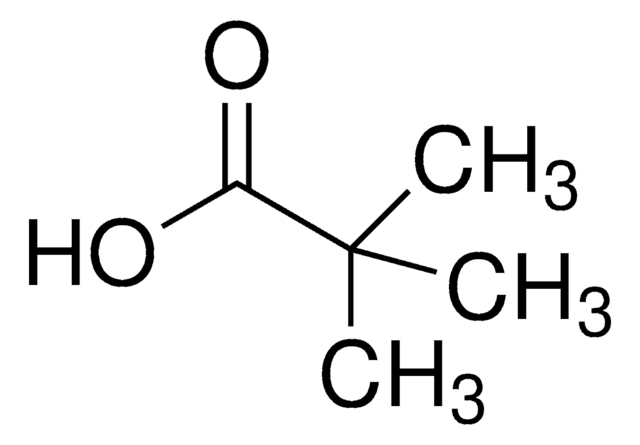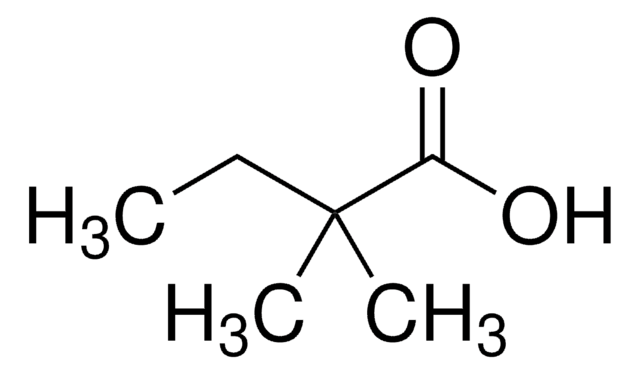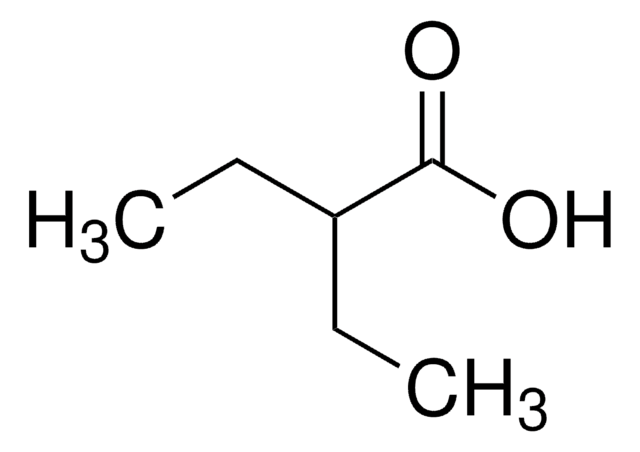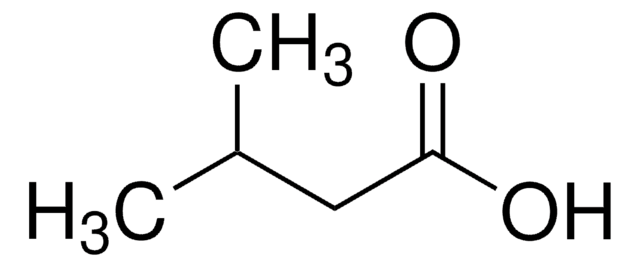8.01336
Pivalic acid
for synthesis
Synonyme(s) :
Pivalic acid, Neopentanoic acid, 2,2-Dimethylpropionic acid, Trimethylacetic acid
About This Item
Produits recommandés
Pression de vapeur
0.85 hPa ( 20 °C)
Niveau de qualité
Forme
crystals
Puissance
900 mg/kg LD50, oral (Rat)
1900 mg/kg LD50, skin (Rat)
Limite d'explosivité
1.6 % (v/v)
Pf
32-35 °C
Température de transition
flash point 64 °C
Solubilité
25 g/L
Densité
0.91 g/cm3 at 20 °C
Température de stockage
2-30°C
Chaîne SMILES
OC(=O)C(C)(C)C
InChI
1S/C5H10O2/c1-5(2,3)4(6)7/h1-3H3,(H,6,7)
Clé InChI
IUGYQRQAERSCNH-UHFFFAOYSA-N
Application
- Regiodivergent synthesis involving pivalic acid: A ligand-controlled regiodivergent C-H alkenylation process using pivalic acid, advancing the synthesis of complex indazoles and potentially impacting pharmaceutical compound development (Kim et al., 2017).
- Pivalic acid in radiochemical syntheses: The study utilized pivalic acid derivatives for the synthesis of novel radioiodinated pharmaceuticals for hypoxia imaging, highlighting its utility in diagnostic and therapeutic applications in the medical field (Elsaidi et al., 2019).
- Capillary electrophoretic applications of pivalic acid: Research explored new methods of cationic electrophoretic focusing using pivalic acid for high-sensitivity analysis of water contaminants, providing insights into environmental monitoring techniques (Malá and Gebauer, 2022).
- Cyclative coupling using pivalic acid: Zhuang et al. described a novel cyclative C-H/C-H coupling technique facilitated by pivalic acid, which rapidly constructs complex molecular frameworks like tetralin and chromane, useful in drug discovery and development (Zhuang et al., 2021).
Mention d'avertissement
Warning
Mentions de danger
Conseils de prudence
Classification des risques
Acute Tox. 4 Oral - Eye Irrit. 2 - Skin Irrit. 2
Code de la classe de stockage
11 - Combustible Solids
Classe de danger pour l'eau (WGK)
WGK 1
Point d'éclair (°F)
147.2 °F - closed cup
Point d'éclair (°C)
64 °C - closed cup
Certificats d'analyse (COA)
Recherchez un Certificats d'analyse (COA) en saisissant le numéro de lot du produit. Les numéros de lot figurent sur l'étiquette du produit après les mots "Lot" ou "Batch".
Déjà en possession de ce produit ?
Retrouvez la documentation relative aux produits que vous avez récemment achetés dans la Bibliothèque de documents.
Notre équipe de scientifiques dispose d'une expérience dans tous les secteurs de la recherche, notamment en sciences de la vie, science des matériaux, synthèse chimique, chromatographie, analyse et dans de nombreux autres domaines..
Contacter notre Service technique








